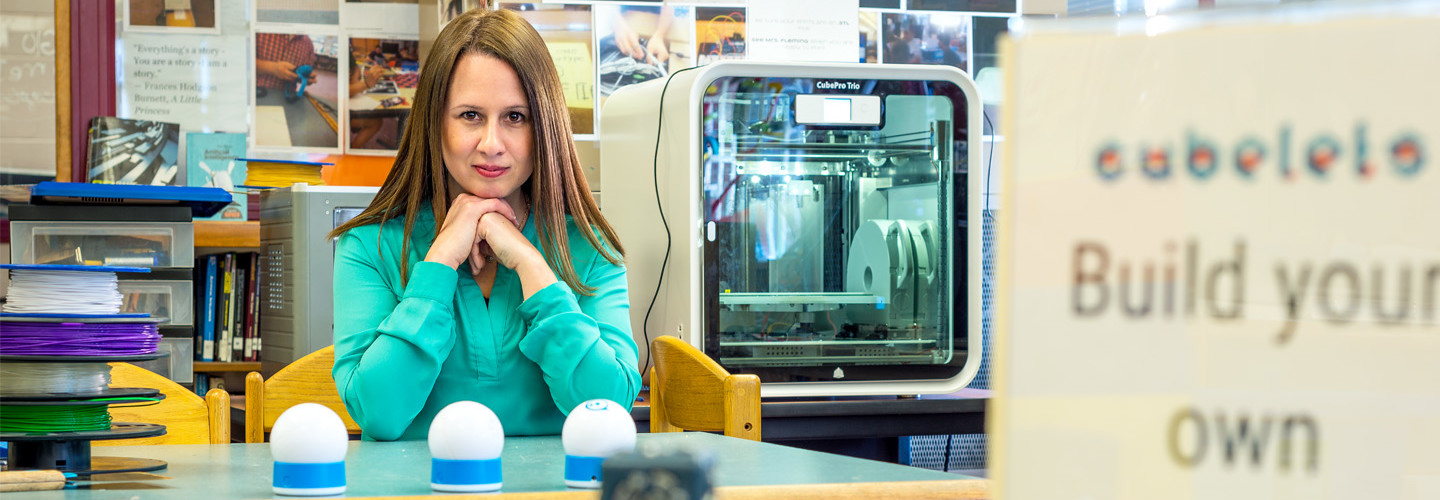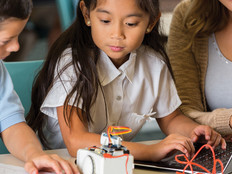Q&A with Makerspaces Innovator Laura Fleming on the Best Creative Spaces in K–12
Laura Fleming has quite a bit of knowledge about makerspaces. She’s created them at the elementary, middle and high school levels.
A former classroom teacher, Fleming became a library media specialist at New Milford High School in New Jersey at the behest of her principal, Eric Sheninger, also a well-known education figure. A frequent blogger and makerspace advocate, Fleming also is author of the bestselling Worlds of Learning: Best Practices for Establishing a Makerspace for Your School.
Fleming spoke recently with EdTech Managing Editor Jena Passut about makerspaces and how she makes the best spaces for the kids in her school.
EDTECH: How did you first become interested in makerspaces?
FLEMING: This is my 19th year in education. I started out as a classroom teacher. My school was renovating its library, and they wanted someone with a technology background to come in. I have a master’s degree in educational technology, so they asked me if I wanted to move into the library. It was the best thing I ever did. I’ve been a school librarian now for probably 13 years or so.
My involvement in makerspaces goes back to when I was an elementary school librarian. A lot of times, people think about STEM [science, technology, engineering and math] when they think about makerspaces, but my point of entry was actually through literacy. I integrated those “making” concepts into the lessons that I taught on a daily basis and I gave my students as many opportunities as possible to “play with story.”
EDTECH: What are some common elements in successful makerspaces?
FLEMING: A lot of people think it’s the technology that pushes kids outside of their comfort zone, but for me it’s not about the technology at all. It’s about having the opportunities for that open-ended exploration and to take control of their own learning. All good makerspaces put kids first in all that they do. The voice of the learner is an essential part in creating a makerspace. Without the voice of the learner, you have a bunch of stuff in the corner.
EDTECH: Is there a big difference between makerspaces in elementary, middle school and high school settings, or is there a common theme?
FLEMING: I really feel lucky at this point to have taught and been a librarian in grades kindergarten through 12 because I think it has given me a lot of perspective. This is just my opinion, but I don’t see much of a difference at all in what a kindergarten makerspace looks like and what a high school makerspace looks like. Makerspaces are just a metaphor for allowing students to have the opportunity to engage in open-ended exploration. It’s about creating a unique learning environment and doing what’s best for kids.
EDTECH: How have you made the most of what you have? What does your space look like?
FLEMING: To create our space, we repurposed some existing library furniture. This is furniture that has been here probably for 20 or 30 years. They’re traditional library tables with traditional seating. My students glued Lego plates onto one of those old library tables and created their own Lego table.
Our bookshelves are built into the heating system in our library and can’t be removed, so we had our custodians install right on top of the bookshelves what we call our LittleBits bar, which is made out of an old work table that one of our IT guys had sitting in his garage at home. I think repurposing what we have really lends itself to that whole maker mindset. We also have made the most of what we have in terms of the materials and supplies that we have in our space. To start a makerspace, I recommend that people use some kind of planning process.
EDTECH: What does your planning process look like?
FLEMING: My planning process starts with the kids and taking the time to understand the learners, finding out what kinds of things they’re interested in, what they like to do in school, what they like to do out of school — basically, uncovering their passions. From there, I move onto assessing existing curricular programs and offerings within the school community. What kinds of things are happening in school that we can pull out and put in the makerspace as an opportunity to democratize learning, make those concepts available for the entire student body as opposed to just one club or class? Also, assess what’s happening at your school. You might find holes in your school that your makerspace can fill.
I believe in a thematic approach to planning a makerspace as opposed to a resource-driven approach. Based on your themes, you can then move on to ordering equipment, materials and supplies.
EDTECH: What does the IT department do to help you set up or maintain your makerspaces?
FLEMING: Our IT guys donated computers to our space. They never give us anything that’s broken; they just give us the things that are running slowly or are a little outdated. The kids take them apart and learn about the different components that make up the system and then, in a lot of cases, they rebuild the computers.
The IT department has been integral; not only have they donated things like their work benches from home and the computers, they have also served as mentors for kids in our space. Having my IT department here to support me has been essential in providing the kids the makerspace that they want.








